
How to Create Empathy Through Writing
It’s not easy to write copy that communicates a message and delivers that message completely on-brand all while making people feel something. In fact, emotional copywriting is hard. I know this all too well.
To evoke emotions through writing, you have to show empathy – you have to show that you understand. Feeling understood is something humans inherently desire. And if you can awaken that feeling in your prospects and customers, you’ve uncovered a goldmine.
Your copy isn’t there to make people understand, it’s there to make people feel understood.
True empathy is understanding another person’s situation to the fullest. And showing empathy is inarguably the fastest way to build trust and likability with that person.
The pinnacle of every marketing effort should be to build trust with your prospects. Step by step. So, logically, there is no way around making your marketing material more empathetic.
In this post, I’ll share all the techniques I know of on how to make people feel understood through copywriting.
Techniques to Evoke Emotion Through Empathetic Writing
Know Your Audience Intimately
To know what your audience is going through, you have to know your audience. Makes sense, right? The better and more intimately you know the person (or persona, rather) you’re writing for, the more fitting and thus effective your copy becomes. So, make absolutely sure you:
- Conduct thorough research (surveys, interviews, analytics) on your audience: This is a sure-fire way to get insights into your buyer persona you wouldn’t get otherwise.
- Create detailed buyer personas to guide your writing: Envision your target avatar down to the smallest detail, if possible.
- Stay up to date with their evolving needs and concerns: People change, and so does your audience and your offer. Constantly adapt to changing circumstances.
- Acknowledge the different stages of the customer journey: Effectively guide prospects through each stage with targeted copy and imagery that addresses their specific needs and concerns at that specific moment in the journey.
The good thing is, unless you only recently started out, you likely already know your audience well enough. You know what type of person you serve and who responds to your offer the best. Double down on tailoring your offer and copy to that specific persona.
Here’s a very detailed article on how to define your ideal customer avatar, should you wish to know more.
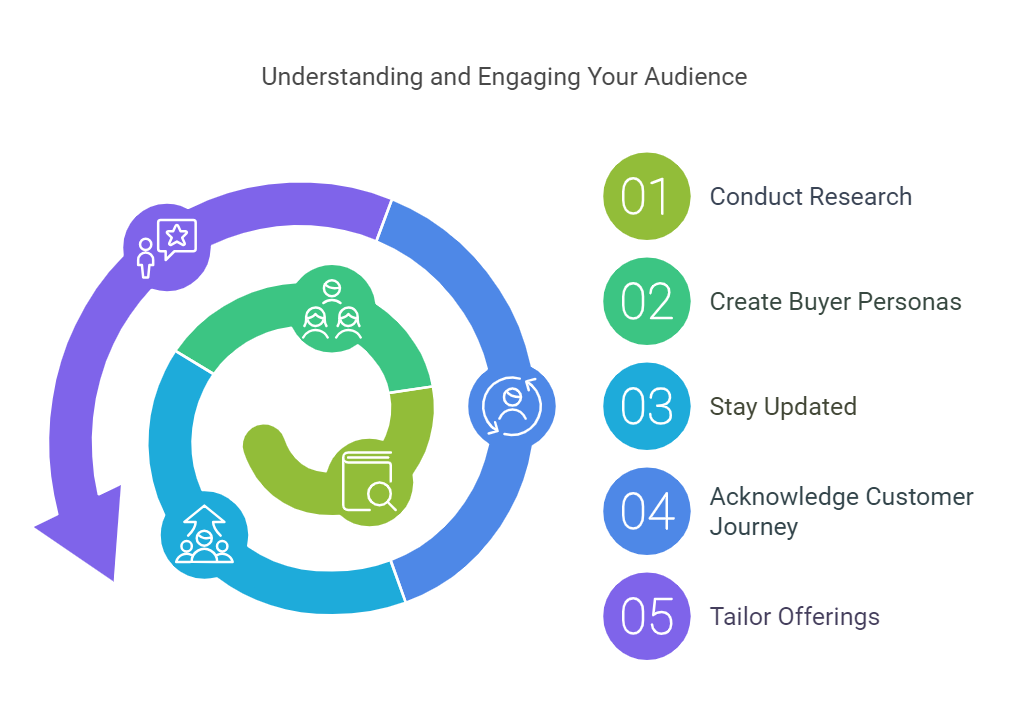
Position Your Customer as the Hero
Many businesses make the mistake of positioning themselves front and center. But the sad reality is, only the rarest of unicorns cares even the slightest about you or your business. On top of that, nobody likes people (or companies) who like talking about themselves, right? So, never forget to:
- Make your customer the focus of your message, not your brand: Talk about what they will get, how they will feel, and what their life will look like after using your product or service.
- Use “you” language and address your reader directly: This makes them feel like you’re speaking directly to them and that you care about their individual needs.
- Highlight customer transformations and success stories: This helps potential customers see how your product or service has helped others achieve their goals and provides social proof that it works.
Refrain from using “we” or “I” language (other than on an “About” page, for example) in anything copy. You are not the hero. The customer is. People don’t care about you. They care about themselves.

Use Strong, Emotive Language
Emotive Language is a sequence of words chosen to evoke a strong emotional response from the reader/listener. It uses a lot of trigger words to convey emotion and show empathy.
Trigger words are used to “trigger” emotions because people can “feel” them. They are words ranging from ‘fail’, ‘annoying’, and ‘abuse’ (negative and depressing) all the way to ‘craving’, ‘breath-taking’, and ‘mesmerizing’ (positive and elating).
Use emotive trigger words to make your audience feel something. Together with the following tips, you’ll make them truly feel understood:
- Acknowledge their emotions: “We know how frustrating it can be…” or “You’re not alone in feeling overwhelmed…”
- Use empathy statements: Sentences such as “Like you, I’ve…” or “I understand how you feel…” can help establish a connection with your reader and show that you’ve been in their shoes.
- Validate their experiences: “Many of our customers have faced similar challenges…” or “We understand that [common pain point] is a real struggle.”
- Show empathy through tone: Adopt a warm, non-judgmental, and supportive tone in your writing.
- Avoid jargon or technical terms: Your audience might not understand overly jargon-y and boring descriptions of your offer. Stick to “easy words” wherever possible.
I’ve made sure to put all the strongly emotive trigger words from this section in cursive, by the way. Hope it helps.
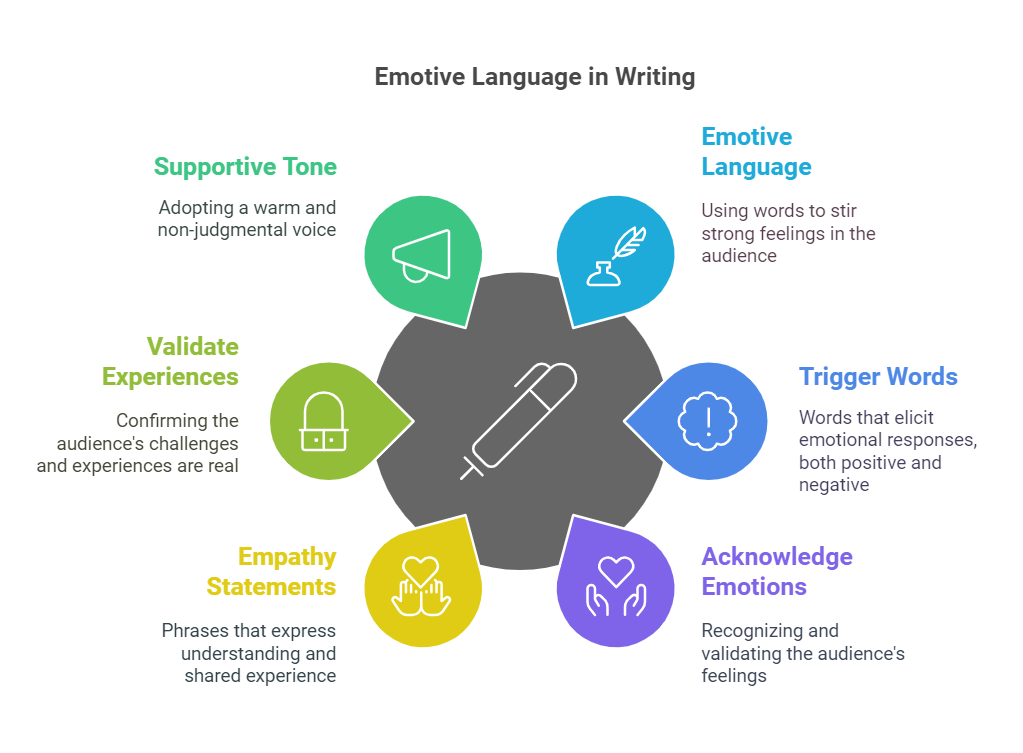
Mirror Their Thoughts and Feelings
By showing that you know what your prospects think and feel and by expressing those thoughts and feelings in words, you show that you truly understand – without having to be asked beforehand.
Proactively address your potential customers’ pain points and worries. Make them sure of the fact that you understand them and their problems. Here’s how you achieve this:
- Reflect their inner dialog: “Are you tired of [common problem]?” or “Have you ever thought, ‘[specific concern]’?” Ask questions that address a problem you know your audience has and will answer with “yes”.
- Use their language and tone: Incorporate the words and phrases your audience uses to describe their challenges or desires. This helps them feel like you’re on their level and that you understand their perspective.
- Explain the problems your audience faces:Talk openly about the ‘taboos’ and make them part of the conversation.Explain that you know the stress and pain that comes with the taboo. More on this later.
Don’t just tell people that you know what being in their shoes feels like – Actively prove it to them by using their own wording, their own inner dialog, and by addressing the taboos only an insider would know of. Mirror their worries.
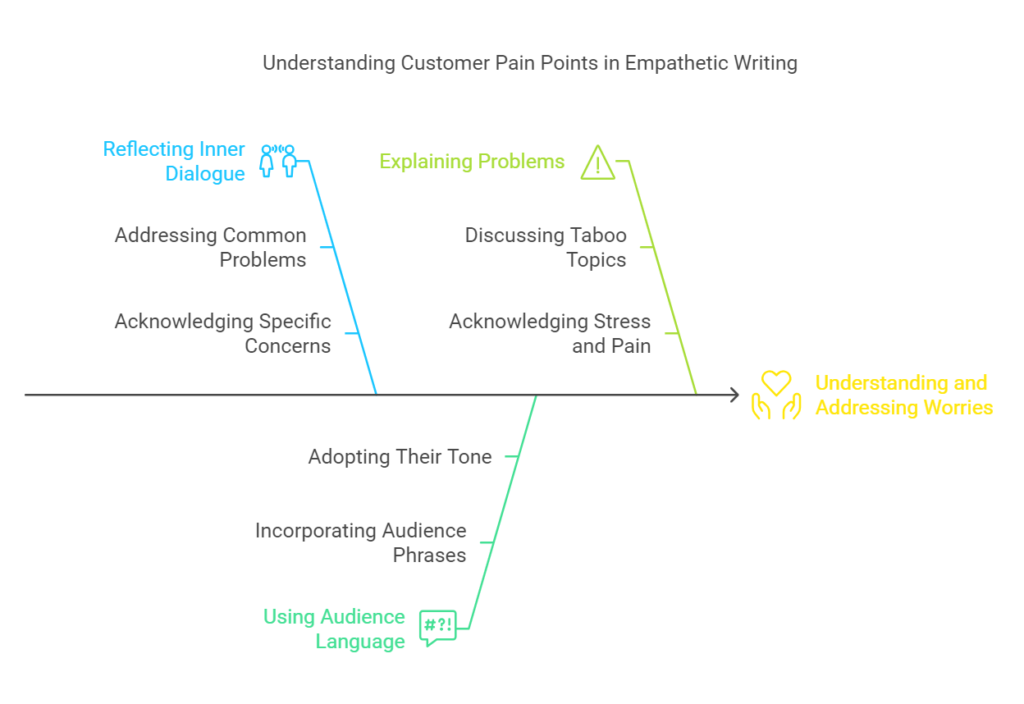
Share Relatable Stories and Analogies
People love stories. That’s nothing new. So why not share your own story to illustrate that you’ve been in your audience’s shoes before? Here’s how:
- Personal anecdotes: Share your own experiences or those of your team members to illustrate empathy and understanding.
- Customer success stories: Highlight how others in similar situations have found solutions with your help.
- Analogy and metaphor: Use relatable comparisons to explain complex concepts or emotions, making them more accessible and understandable.
By sharing your story and, ultimately, the happy resolution of your story, you’ll not only prove that you’ve been there, but also show that you know the solution. This builds trust in your ability as a guide to relieve your audience of their problem.

Address the Unspoken
People don’t like talking about their fears, problems or pains with complete strangers. This is why it’s your job to address them, so your audience doesn’t have to.
Addressing the unspoken truly proves that you know your audience’s situation. Especially if you mention a fear, problem or pain you’re audience experiences without consciously knowing it, you’ve won the jackpot.
This, again, highlights why it’s so important to understand your target customer avatar better than they understand themself.
So, to boost empathy by addressing the unspoken:
- Tackle taboos or sensitive topics: Show that you’re willing to discuss the uncomfortable, demonstrating a deeper level of understanding.
- Recognize the elephant in the room: Acknowledge the obvious challenges or concerns that others might avoid discussing.
- Address problems and pain points head-on: Your audience has them, but they might just not know it yet.Explain what their problems and pains are, then show how your offer will make their lives better and solve their problems.
After you’ve spoken about the things nobody else speaks of, try to position your offer as the solution to them.
Position your offer as something that will help relieve your audience of their issue. In doing so, focus on the benefits that your product or service offers, rather than its features.
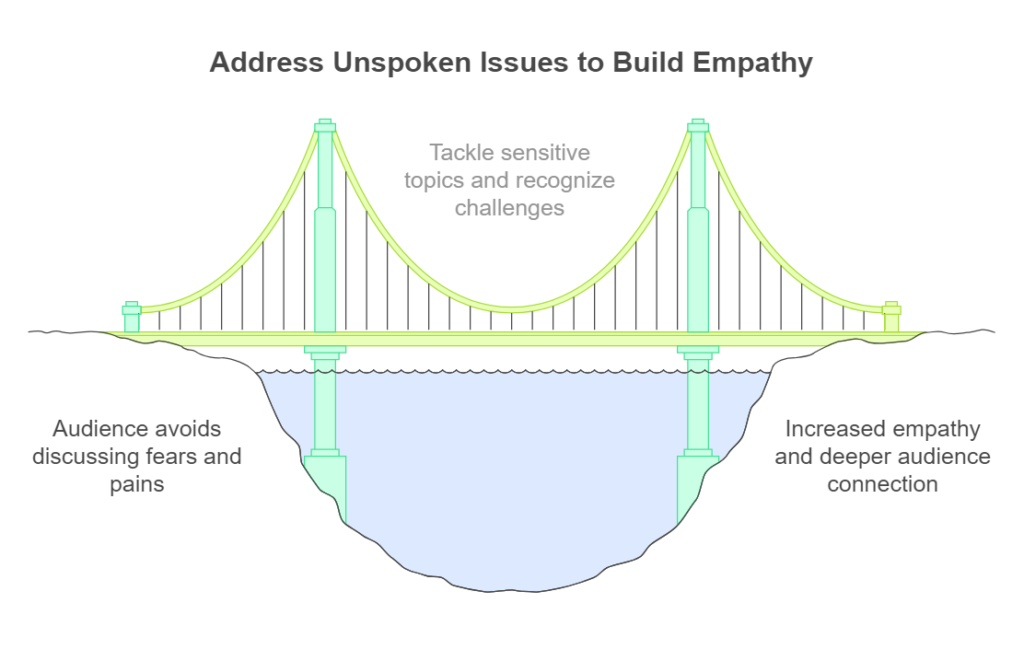
Show, Don’t Just Tell
Don’t just tell people you understand their pain points – prove it. Use detailed descriptions and vivid language that accurately reflects their experiences.
For example, instead of saying, “Are you stuck in your 9-5 and don’t know how to get out?,” try something like, “Are you suffocating in the daily grind of your 9-to-5, longing for the freedom to be who you’ve always wanted to be?”
The second example uses stronger emotional language and paints a more specific picture of the target audience’s feelings.
Then, use stories and examples that are relatable to your audience. This helps them see themselves in your message and feel like you’re speaking directly to them.
Incorporate “emotionally strong secondary elements” that your target audience can relate to. This could involve using imagery or language that evokes positive memories or associations – ideally of who they aspire to be.
For example, a fashion brand targeting affluent individuals in Zurich might shoot their ad on a speedboat in the Zurich bay area during the summer to tap into the aspirational lifestyle of their target customer.
So, to show that you know what you’re talking about:
- Use vivid, descriptive language: Paint a picture with your words to help readers immerse themselves in the narrative. “Mental images” is the key phrase here.
- Provide actionable advice or solutions: Demonstrate your understanding by offering practical help. Give people unexpected solutions to their problems unsolicited and for free.
- Use information that proves you have been there: Anyone can just claim things. By describing situations you wouldn’t know of unless you’ve actually been there, you prove that you truly have the expertise and knowledge.
- Know who your audience is and who they want to be: Prove to them that you know and share their vision of where and who they want to be.
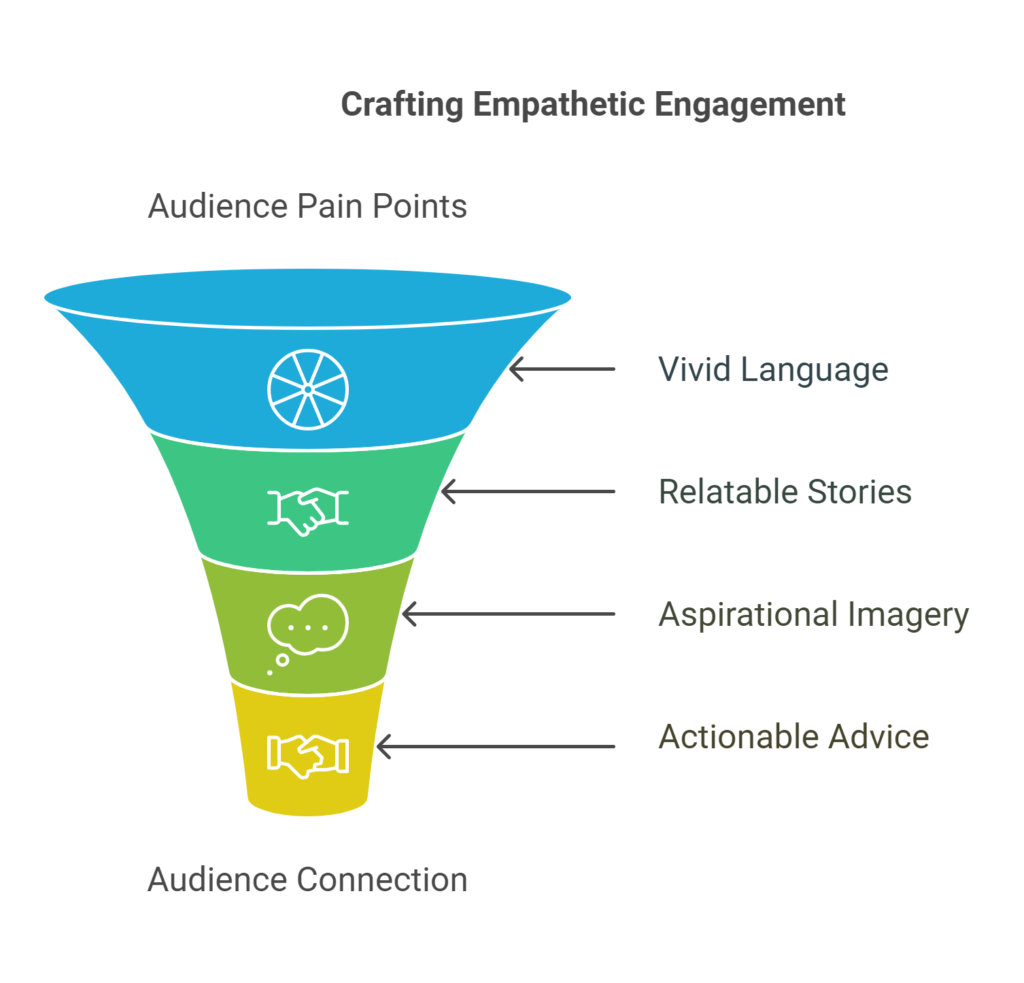
Be Vulnerable and Authentic
Own your flaws and don’t be afraid to show vulnerability. This makes you more relatable and human. People are more likely to trust someone who is open and honest about their imperfections.
- Admit when you don’t have all the answers: Show that you’re on a journey of discovery alongside your audience.
- Share lessons learned from failures: Highlighting your own vulnerabilities can foster a deeper sense of connection.
- Address objections head-on: Don’t try to avoid the negative – acknowledge it but don’t forget to explain how your product or service overcomes those concerns.
Opening up and sharing your flaws shows that you’re human. But if you only show your mistakes and don’t show how you solved your problem, you’re missing out on a huge piece of the puzzle to truly empathy-proving writing.
You absolutely HAVE TO provide a path to salvation, a shred of hope, a glimmer of light at the end of the dark tunnel. Prove that you’ve made the same mistakes as your audience but that you know how to overcome them. Then tell them how to overcome them.
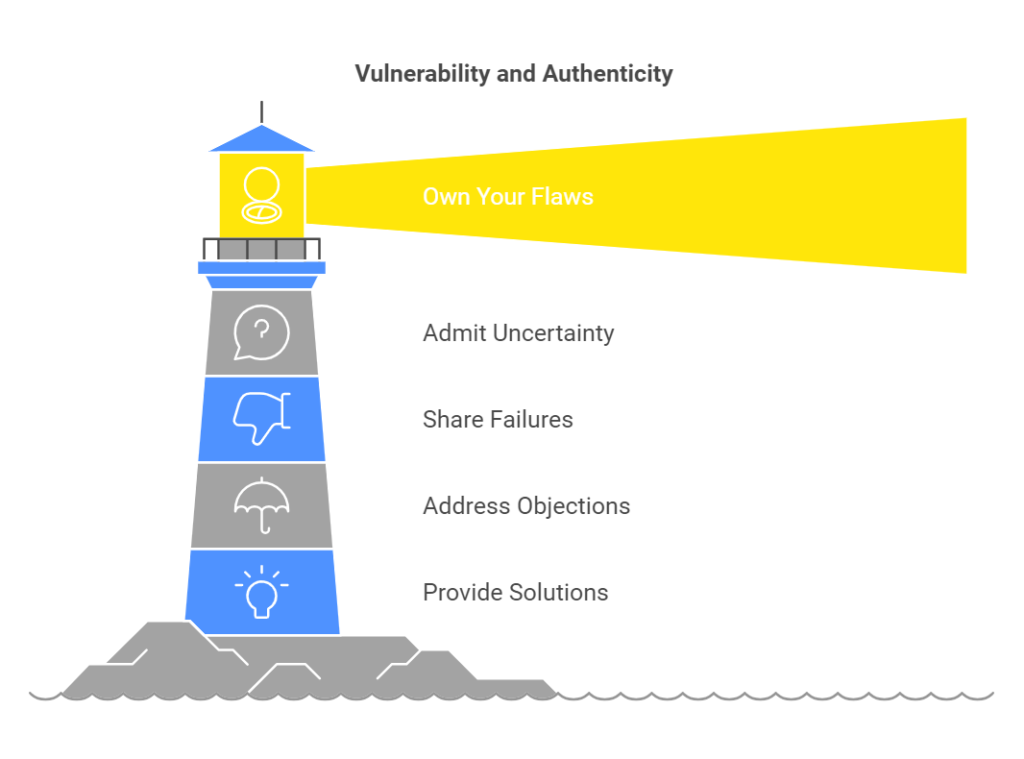
Adjust and Refine
Use feedback to understand how your audience responds to your message and adjust as needed. This shows that you’re listening and that you’re committed to providing value – not just in short term.
- Analyze the performance of your message: Use digital tools to make sense of audience behavior to your content. Let’s leave it at that for this post and not go down the rabbit hole.
- Make strategic changes: Use A/B testing to find out which version of your copy truly resonates the most with your audience. Then iterate to your liking.
You can’t and won’t get the perfect take on your writing right from the get-go. But over time, you can inch closer to something that resembles nigh perfect, empathetic copywriting.
Just know that you’ll never actually reach perfection. That’s just not possible.
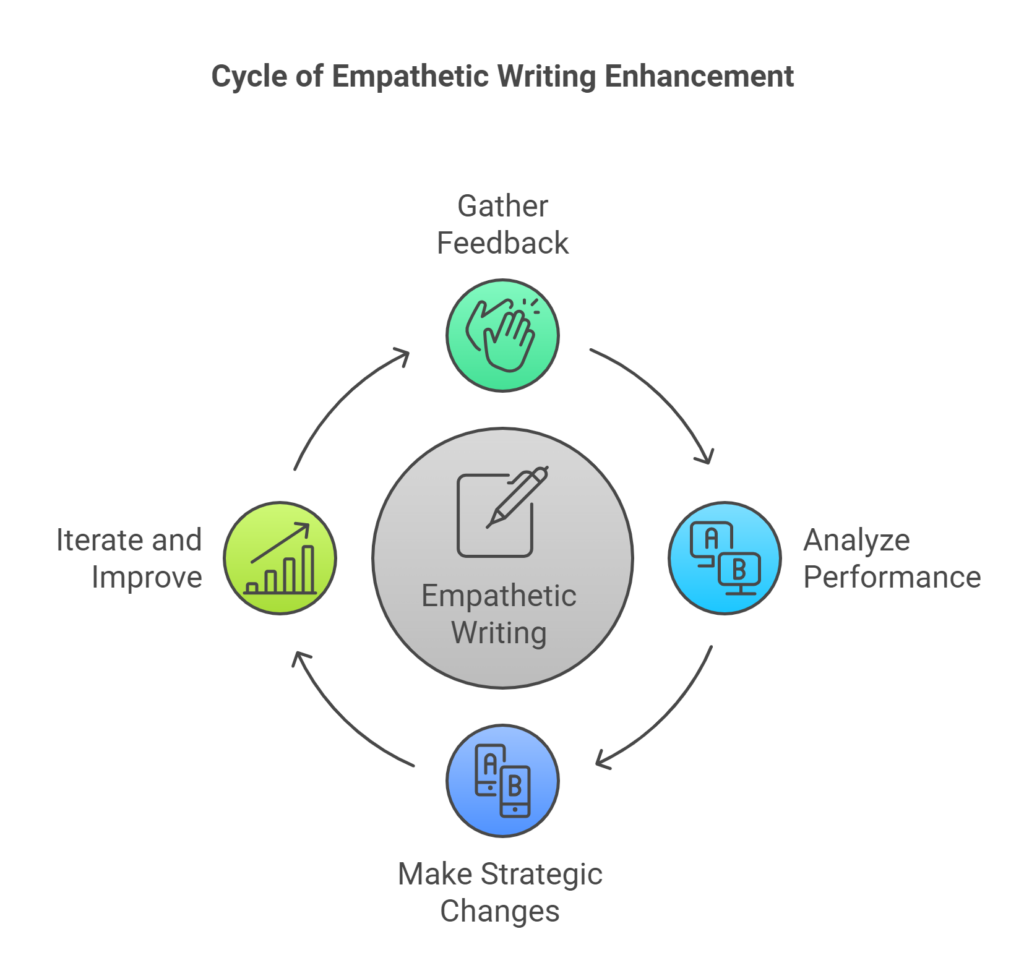
Example of Empathetic Writing
If this post wasn’t example enough, here’s a hands-on example of empathetic writing in action.
Before (Informative but Not Empathetic):
“Are you struggling with weight loss? Our new diet plan can help you lose up to 10 pounds in a month.”
After (Empathetic and Understanding):
“We know how defeating it can feel to try diet after diet, only to see the scale barely budge. The frustration, the guilt, the feeling like you’re failing yourself… It’s a cycle many of us have been trapped in. But here’s the truth: it’s not your fault. Our bodies are complex, and what works for one person might not work for another. That’s why we’ve developed a personalized weight loss plan, tailored to your unique needs and lifestyle. Because we believe you deserve to see real progress, without the emotional rollercoaster. Let’s break the cycle together.”
Sure, the second version is longer, but it grabs the reader’s attention for longer and is much more enjoyable to read, right?
Copy is never too long. It can only be too boring. And copy that pulls on a person’s heart strings and triggers an emotional response is never boring.
But in any case, here’s an emotionally charged short version:
After (Empathetic and Understanding YET ALSO Short):
“We know the struggle of weight loss. Imagine a weight loss plan that frees you of that guilt, frustration and feeling of constant defeat. Well, we’ve got a proven one – tailored to you and your specific needs. The struggle was never your fault, but together we can change it.”
Your copy isn’t there to make people understand, it’s there to make people feel understood.
Exercise to Enhance Your Empathetic Copywriting Skills
- Choose a recent piece of your content.
- Who does this piece of content speak to? Who is this person? What are their problems, concerns and pain points?
- Identify the primary emotion or challenge you’re addressing.
- Rewrite the content incorporating at least three of the emotion-evoking and empathy-proving techniques listed above. Each of these techniques should speak to at least one of the emotions or challenges.
- Share both versions with a small group of your target audience and gather feedback on which one resonates more deeply with them.
- Refine your approach based on the insights gained. And repeat 5 and 6 as often as you deem necessary. The more granular you go, the more emotional and empathetic your copy will get.
Final (Empathetic) Words
Writing copy that truly gets your audiences blood pumping is hard. Really hard. And it takes a lot of practice, trial, and error to get the hang of.
And though it might feel overwhelming and as if you’ll never be able to write emotionally or empathetically, know that this will change over time with just a little bit of dedication to the craft.
I know this because I’ve been there too. I’ve written hundreds of lines of text I wish I could go back and rewrite using the techniques I know now. And I envy you, my friend – for two reasons:
First, you still get to experience the transformation of your writing skills.
And second, you have – with this post, no less – a blueprint for emotional, empathetic copywriting in your hands (or on your screen, rather).
Use the knowledge from this post to fast-track your writing success and boost your text-based marketing efforts. Read this eye-opening article for more tips on that, by the way.
And never forget:
Your copy isn’t there to make people understand, it’s there to make people feel understood.
How do I measure the effectiveness of empathetic writing?
Track changes in key metrics after implementing empathetic copy. Look for increases in engagement (likes, shares, comments), conversions (sales, sign-ups), positive customer feedback (reviews, surveys), and improved brand sentiment (social listening). A/B test different versions of your copy to see which resonates best.
What are some specific examples of empathetic writing for different industries/niches?
Healthcare: Instead of “Schedule your appointment today,” try “We understand that scheduling medical appointments can be stressful. We’re here to make the process as easy as possible for you.”
Finance: Instead of “Invest now and grow your wealth,” try “Navigating financial decisions can feel overwhelming. We’re here to provide clear guidance and support every step of the way.”
SaaS: Instead of “Sign up for a free trial,” try “We know you’re busy. That’s why we’ve designed our platform to be intuitive and easy to use, so you can get started quickly and see real results.”
How do I avoid sounding insincere or manipulative when writing empathetically?
Be genuine. Research your audience thoroughly to understand their real needs and pain points. Avoid hyperbole and overly emotional language. Focus on offering solutions and support, not just exploiting emotions. Ensure your actions and business practices align with the empathy you express in your writing. If you don’t truly care, it will show.
Resources Used to Write This Article:
Aristotle. (350 BCE). Rhetoric. Translated by W. Rhys Roberts.
Read the pdf
Cialdini, R. B. (2007). Influence: The psychology of persuasion (Revised ed.). HarperCollins Publishers.
Check out book
Kahneman, D. (2011). Thinking, fast and slow. Farrar, Straus and Giroux.
Check out book
Pinker, S. (2007). The stuff of thought: Language as a window into human nature. Viking.
Check out book
